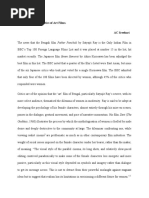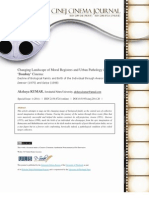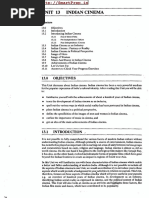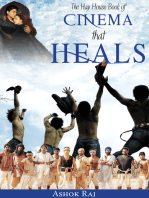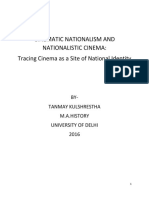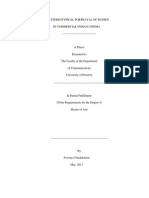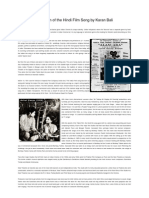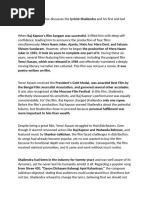Cinema
Cinema
Uploaded by
shibudibuomiCopyright:
Available Formats
Cinema
Cinema
Uploaded by
shibudibuomiCopyright
Available Formats
Share this document
Did you find this document useful?
Is this content inappropriate?
Copyright:
Available Formats
Cinema
Cinema
Uploaded by
shibudibuomiCopyright:
Available Formats
INDIAN CINEMA: Then and Now
Author(s): PARTHA CHATTERJEE
Source: India International Centre Quarterly , AUTUMN 2012, Vol. 39, No. 2 (AUTUMN
2012), pp. 45-53
Published by: India International Centre
Stable URL: https://www.jstor.org/stable/41804040
JSTOR is a not-for-profit service that helps scholars, researchers, and students discover, use, and build upon a wide
range of content in a trusted digital archive. We use information technology and tools to increase productivity and
facilitate new forms of scholarship. For more information about JSTOR, please contact support@jstor.org.
Your use of the JSTOR archive indicates your acceptance of the Terms & Conditions of Use, available at
https://about.jstor.org/terms
India International Centre is collaborating with JSTOR to digitize, preserve and extend access to
India International Centre Quarterly
This content downloaded from
104.211.220.240 on Thu, 05 May 2022 18:04:11 UTC
All use subject to https://about.jstor.org/terms
PARTHA
CHATTERJEE
Cinema,
Cinema, state psyche,
state ofofitbeing, psyche,
which being, said, may andinwhich
andis which, usually maymay
turn,which, possibly ispossibly
in be a turn,
be affected be responsible
fair responsible
by the forof itsitsa (current)
may indicator be for affected (current)
nation's by the
turn of historical, political and economic events in a given frame of
time. This observation may be brought to bear to reflect the state of
Indian cinema and that of the Indian nation over the last 65 years,
that is, since independence from British rule in 1947. The Indian
subcontinent was cleaved in two, and out of it India and Pakistan
were created; an exercise that left 1.8 million people dead, an equal
number of women sexually violated and a psychologically scarred
population on both sides of the border. Despite this monumental
tragedy, Indian cinema, particularly the Hindustani or Hindi
cinema of Bombay, surged ahead. In India nation-building energies
were at work which got reflected in the films made particularly in
Hindi and Bengali.
The reason for this happening was most likely due to the fact
that three provinces of Northern India, namely, Punjab, Bihar and
Uttar Pradesh, and from the East, undivided Bengal, bore the brunt
of the Partition, and film-makers, script- writers, lyricists, musicians,
actors, who came across had a richer fund of experience and a
deeper commitment, perhaps subconsciously, towards culturally
enriching a 'newborn' nation called India. From the mainstream
cinemas of Bombay and Calcutta emerged, within the first decade,
very talented directors such as Mehboob Khan, Bimal Roy, Raj
Kapoor, Guru Dutt, Satyajit Ray and Ritwik Ghatak, the last two
making films in Bengali, and having the term 'genius' attributed to
them and their work by the cognoscenti at home and abroad.
45
This content downloaded from
104.211.220.240 on Thu, 05 May 2022 18:04:11 UTC
All use subject to https://about.jstor.org/terms
lie QUARTERLY
The doctrine of Nehruvian socialism
after the banning of the Communist Part
the armed struggle against the Indian
1948. The Indian National Congress was r
Jawaharlal Nehru was the first Prime Mi
preached gradual, decisive social chan
means rather than violence to bridge
teeming poor and the very few rich, w
natural resources, though not as rapac
Many members of IPTA (Indian People
the cultural arm of the CPI, drifted into
of Bombay. Raj Kapoor, the son of a wel
theatre and film actor, Prithviraj Kapoor
from the 'Leftist' input in his films. Kh
maker of the moving film, Dharti Ke Lai
famine of 1943 in which five million
Raj Kapoor's script-writer, and Shailendr
emotive range and awareness of the hum
of the most memorable songs for his emplo
Thanks to K. A. Abbas, who adapted h
Kapoor's Arya Samaji upbringing, and adding
a dash of lilting romance, films such as Bar
Desk Mein Ganga Behti Heye became great h
in the erstwhile Communist Soviet Union. The commercial success
of these films, in no small measure, was due to the music of the
Shankar-Jaikishan duo who, perhaps at Abbas' suggestion, adapted
Bylo-Russian folk tunes and set them to Hindi lyrics, including
Shailendra's 'Awara Hoon' from Aw ara, which became a rage in the
Soviet Union and other Soviet-Bloc countries in Eastern Europe.
Shankar-Jaikishan's music for Raj Kapoor's films were, in the main,
raga-based. They gave the actor-director's films a lift as did the lyrics
of the former fitter in an Indian Railways workshop, Shailendra,
and Hasrat Jaipuri, a bus conductor, for a long time wary of leaving
his job. Last but not least, the iconic presence of the actress Nargis,
rescued the RK films from drifting into bathos.
The cinema of Raj Kapoor, for all its superior craftsmanship,
was tethered to an idea of Utopian socialism, as was Nehru's politics.
The only time Kapoor could cut loose was in Jagte Raho , directed by
two former IPTA members, Shambhu Mitra and Amit Moitra. The
46
This content downloaded from
104.211.220.240 on Thu, 05 May 2022 18:04:11 UTC
All use subject to https://about.jstor.org/terms
INDIAN CINEMA : PARTHA CHATTERJEE
two directors let Raj Kapoor retain his
earlier films, heavily derived from Charl
this one as well. Playing a job-hunting
looking for a drink of water, is accidenta
block of flats. Mistaken for a criminal he
till he turns around and confronts his pu
which has become the stock-in-trade of
political party in India today, was first sh
as an idea in Jagte Raho.
Bimal Roy, a migrant to Bombay
middle-class cinema of New Theatres, C
and cinematic values learnt earlier. Lik
Chandra Chatterjee, he had a 19th-cen
brought into most of his films with cons
as Parineeta, Devdas , both based on Sha
Madhumati, Suj ata and Bandini reflect
His cinema has often been called pat
retained the best aspect of paternalism, n
strings attached. Bimal Roy's portrayal
revealed an understanding of their he
in Indian cinema then or now. His film
Do Bigha Zameen , made at the behest of
Ghosh, a former communist - Naukri and
but they revealed a subtle intelligence
or Guru Dutt, whose work had the ring
Roy's films appeared to bridge the past w
Mehboob Khan, the son of a Gujarat
rose from the ranks. Making his start as
worked his way up to found his own
unlettered man, Mehboob Khan had
and surrounded himself with some ve
covering all aspects of film production
was Aur at, on rural indebtedness, in whi
the crippling role that he still does
himself as a dynamic storyteller with
insights. He re-made the film in the m
was shot in Technicolor and had Nargis
peasant-mother fighting for dignity in a
world where all life-sustaining resource
47
This content downloaded from
104.211.220.240 on Thu, 05 May 2022 18:04:11 UTC
All use subject to https://about.jstor.org/terms
lie QUARTERLY
The film was a huge hit but there was mo
he had made Humayun, on the second M
lost, portions of it, worth an hour, were s
Cannes film festival in France and took di
with its unusual grasp of film language. H
before Mother India. Amar was a strange, c
with powerful undercurrents of sexuality.
Indian politics, still under the sw
Congress, was fast becoming a purve
Well-educated victims of the Partition f
up jobs not commensurate with their abili
from the door. Employment, leave alon
scarce. The idea of building a new natio
Dutt, a former student of the pioneering
Shankar, was perhaps the first 'outside
cinema. His pessimistic view of the worl
second film, and carried over most for
Phool and Sahib Biwi Ghulam , films dispa
in their untrusting stance against a blind,
of Guru Dutt's mise en scene, his master
placement and an uncanny ability to u
nuances of ideas and emotions, made h
director to be celebrated by the French
the critics of Cahiers du Cinema , a hi
film journal.
Bengali cinema in the mid-1950s
film-makers blessed with genius - Satya
Both came from the erstwhile landed class
and artistically inclined families. Ray's g
Roy-Choudhury was not just a zaminda
violinist, an illustrator, the author of a
children's Mahabharata in Bengali and t
first magazine for children in Bengal. S
father, was an illustrator, an exceptionally
rhymes and stories for children, an
Photographic Society of England. Ritw
Chandra Ghatak was a land-owning senio
private library and an extensive knowle
The eldest son, Manish Ghatak too beca
48
This content downloaded from
104.211.220.240 on Thu, 05 May 2022 18:04:11 UTC
All use subject to https://about.jstor.org/terms
INDIAN CINEMA : PARTHA CHATTERJEE
major poet of the Kallol group in the pos
Mahasweta Devi became a distinguishe
human rights activist.
Satyajit Ray, having struggled throug
childhood - his father died when he w
old and his mother had to go to work at
Women in Calcutta as a clay-modeller in
them - after a brief but highly successfu
D.J. Keymer, an English advertising agen
first feature film, Father Panchali over
and '55. His brilliantly cinematic adaptat
Bandyopadhyay's sprawling, poetic, epon
Bengal, took the world by storm.
Ritwik Ghatak got off to a false start w
film in 1952, made largely with the inh
together, post-Partition; the Ghataks, like m
had lost their all in the cataclysmic division
was not released commercially for ext
believed to be lost. Re-discovered and shown some months after his
death on 6 February 1976, it showed an important director in the
making. It was not until Ajantrik , five years later, that Ghatak was
able to fulfil the great promise he had as a director. It was through
the making of their first films that Ray's and Ghatak's respective
destinies were revealed. Getting the Best Human Document Award
at the Cannes film festival in 1955 changed Satyajit Ray's life;
he did not look back after that. The film was a grand commercial
success in Calcutta before it was shown abroad. Ajantrik , Ritwik
Ghatak's dynamic, illuminating adaptation of Subodh Ghosh's story
concerning a moffusil cab driver's love for his jalopy, bombed at the
box-office and was greeted with modest enthusiasm abroad. It took
a major Paris retrospective in 1983 for French critics to appreciate
the enduring merit of this film along with the others made by him.
The overtly politicised Ghatak - he was a communist all
his life - chose the more difficult path of applying the teachings of
Jung, Campbell and Nueman adapted to an Indian context, in his
profoundly expressive films. The idea of womanhood, both idealised
and ruthlessly exploited, in the context of materialism, found a niche
in his films. He developed these ideas with increasing insight in films
such as Nagarik, Meghe Dhaka Tara, Komal Gandhar, Suvarnarekha
49
This content downloaded from
104.211.220.240 on Thu, 05 May 2022 18:04:11 UTC
All use subject to https://about.jstor.org/terms
lie QUARTERLY
and Titash Ekti Nadir Naam. No film of his
Dhaka Tara. Komal Gandhar and Suvarnarekh
commercial success, were made to fail by
and without the CPI. His directorial caree
for bread, an exercise exacerbated by his
His films do tell us, with poetic insigh
struggle for survival of the Bengali lower
Seen beyond their immediate context, G
abiding psychological resonance. His de
mythology, ragas and the political histor
in a unique position among the master fi
Having been brought up in the group-theatr
the value of keeping the audience engage
that cinema was a mass-medium and the
films accessible to the average viewer. He fe
it needed to have many layers of experience
had to make sense to viewers right across th
Ghatak's films were intimately linke
of India, an event that resulted in the la
of population in history. Seen from a lar
about the arbitrariness of political destiny i
people are forced to become citizens of n
countries, build lives for themselves and
spiritual sustenance. The twin themes of
as integral to a larger class struggle appea
Ritwik Ghatak's cinema. The visual-aural effect of such cinematic
forays is often heart wrenching.
Satyajit Ray's cinema for all its outer bourgeois accoutrements
is much quieter, more inward looking. Ray is well aware of the
world he lives in, responsive to its follies but does not turn a blind
eye to them. Unlike his mentor, the great Jean Renoir, who could
look life in the face and say, 'I know you have many faults, some of
them terrible, but I will love you for all that you have and see beauty
in your wondrous face,' Ray takes an unambiguous moral stand on
issues that matter to him and can be quite hard on hypocrites and
wrong doers without losing his sense of humour, at least in his best
work. If the Apu Trilogy - Father Panchali, Aparajito, Apur Sansar -
heralds the coming of a most perceptive lyric poet in cinema,
subsequent films reveal poetic dimensions other than lyricism.
50
This content downloaded from
104.211.220.240 on Thu, 05 May 2022 18:04:11 UTC
All use subject to https://about.jstor.org/terms
INDIAN CINEMA : PARTHA CHATTERJEE
Parash Pathar , based on a Parashuram (R
not only a hilarious fantasy about a poor, ol
of stone that can turn any metal to gold, w
is also a canny look at the mores of the lo
the protagonist belongs, and those of the up
rich he encounters as he goes up in the wor
Ray, a man of aristocratic origins lik
his interest in the study of human being
emanate from the conduct of his charact
was not true of any film-maker? If so, t
from any other film-maker of note? Ray is
and Ghatak, for all his impassioned concern
films, is an essayist. In Ray, the story an
central to arriving at a vision of the world;
world already exists in him thanks to his
historical inevitability; his characters fit in
and still manage to live vital lives.
Satyajit Ray and Ritwik Ghatak made
and an ethical viewpoint. They, while be
follies on the whole, were highly critical of
though subtly. Ray, possibly due to an early
of Charles Chaplin and Vittorio de Sica b
downtrodden, though his range of conce
The quiet battle between the classes dep
classic of 'real-time' cinema, that is, the w
same span of time as the length of the fi
gave way to Charulata adapted from a Ra
about a married, gifted, lonely upper-cl
century Bengal, to Mahanagar, set in the
when there was a spate of closures amongst
the bankruptcy of needy account holder
whom the film is centred, lose their jobs.
Ray's concern over the fate of his
protagonist in Pratidwandi rings true 41
confirmation of the thesis, 'nature is bou
boundless' in Asani Sänket , made a coupl
a novel by Bibhuti Bhushan Bandyopadhy
of 1943. During the 18-month Nation
declared by Prime Minister Indira Gandh
51
This content downloaded from
104.211.220.240 on Thu, 05 May 2022 18:04:11 UTC
All use subject to https://about.jstor.org/terms
lie QUARTERLY
the Centre, when others cringed in fear,
as an ironic but really intelligent analysi
middle class made soul-killing compromi
status quo. The film did not go down we
Minister's Office) despite its fictional conten
his (never overt) political analysis of the
their psychology in the period-piece, Sh
the overthrow of Nawab Wajid Ali Shah o
General Outram of the East India Company o
after, Ray made a very entertaining and i
Sonnar Kella , about parapsychology. T
directed a sparkling anti- war musical, Gopi
ended his career despite ill-health on a hi
bound Aguntuk, his last will and testame
seeking of knowledge for the pleasure of
profit-making philistinism.
Through the 1960s and 70s, the poor
be poor but the middle class, very slowly,
The quality of education was falling, gradual
wars: one disastrously with China in 1962, an
'65 and then in '71; both resulted in pyrrhic
slender economic resources. The only film of
of Hindi cinema soon after was M.S. Sathy
script by Ismat Chughtai and Kaifi Azmi.
a middle-class Muslim family from Agra, riv
carried a palpable sense of truth.
A 'Black' economy ran parallel to the
the mid-'70s and has carried on with var
into our times, where it seems to be flou
before. No film, mainstream or otherw
phenomenon, or any aspect of it. Kum
(1976-84), a masterly depiction of the fa
industrial family. The narrative had incid
ones from the Mahabharata. Shahani did make another excellent
film, Kasha , in 1989, set in a small town in Himachal Pradesh. His
updated adaptation of Anton Chekhov's story, In The Gully , took in
its stride the nexus between the aspirational greed of an individual
and government departmental power and its role in the destruction
of an influential family.
52
This content downloaded from
104.211.220.240 on Thu, 05 May 2022 18:04:11 UTC
All use subject to https://about.jstor.org/terms
INDIAN CINEMA : PARTHA CHATTERJEE
In Kerala, unusual directors such as A
John Abraham and G. Aravindan flo
peculiar to their own temperament. Gop
studies of certain aspects of Malayali fe
Mathilukal, Vidheyan, Nizalkuthhu and
communist trade unionist, M ukhamukham
only four films before his premature de
last, Amma Aryan , about a disappear
sympathies. Abraham's great strength
touching memories of a person or a plac
cartoonist and trained musician, had an
stories into poetic ruminations. His mem
Sita - a reworking of the myth of Sita fro
a tribal perspective - Thampu, Esthapan
and Vasthuhara. But for the last two film
world of sorrow, his other films are tou
and of love, as in the act of giving.
With the departure of Ray and Gh
ceased to produce films of any conseq
Buddhadev Dasgupta and Rituporno G
have been celebrated at minor film fest
their idiosyncracies than their work. Th
interesting perspective on life nor art.
Among the few fine films of the la
Shah's farce, Jaane Bhi Do Y aar on, that
connection between the Press and dirty
both officials and politicians. The other
Mokashe's Harish Chandra Chi Factory abou
pioneer Dadasaheb Phalke. The film is ma
light, witty touch. One must not forget
and truly experimental films, Gaja Gamini
aspects of the feminine psyche with lo
captures the aspirations of both, the exploi
our failed political system, is itself rotten,
Gangs of Wasseypur ; it is directed by Anur
The state of India and Indian cinema
neither promising sustenance for the body
♦
53
This content downloaded from
104.211.220.240 on Thu, 05 May 2022 18:04:11 UTC
All use subject to https://about.jstor.org/terms
You might also like
- Producing Bollywood by Tejaswini GantiDocument41 pagesProducing Bollywood by Tejaswini GantiDuke University Press100% (1)
- Bhuvan Shome 1Document13 pagesBhuvan Shome 1Muhammed Afzal PNo ratings yet
- The Politics of Humanism - AN INTERVIEW WITH SATYAJIT RAY - Udayan Gupta and SATYAJIT RAYDocument7 pagesThe Politics of Humanism - AN INTERVIEW WITH SATYAJIT RAY - Udayan Gupta and SATYAJIT RAYTavarishNo ratings yet
- Jaikumar BollywoodSpectaculars 2003Document7 pagesJaikumar BollywoodSpectaculars 2003werewolf overpowered1No ratings yet
- Representation of Partition in Hindi Films of The Nehruvian EraDocument8 pagesRepresentation of Partition in Hindi Films of The Nehruvian EraTJPRC PublicationsNo ratings yet
- Knocking at The Doors of Public Culture - Indias Parallel CinemaDocument17 pagesKnocking at The Doors of Public Culture - Indias Parallel CinemaIshan Santra100% (1)
- The Majoritarian Politics of Art FilmsDocument10 pagesThe Majoritarian Politics of Art FilmsA.C. SreehariNo ratings yet
- Cambridge University Press Modern Asian StudiesDocument33 pagesCambridge University Press Modern Asian StudiesSayantan MondalNo ratings yet
- Board of Regents of The University of Oklahoma University of OklahomaDocument7 pagesBoard of Regents of The University of Oklahoma University of OklahomaevandropasseroNo ratings yet
- What Is Wrong With Indian FilmDocument5 pagesWhat Is Wrong With Indian FilmwfshamsNo ratings yet
- Indian Cinema and The Bourgeois Nation StateDocument9 pagesIndian Cinema and The Bourgeois Nation Statesobhanap02No ratings yet
- Cinema in IndiaDocument9 pagesCinema in IndiaTapanshu KulNo ratings yet
- Datta-GlobalisationRepresentationsWomen-2000Document13 pagesDatta-GlobalisationRepresentationsWomen-2000mehersp79No ratings yet
- Gupta IndianCinemaToday 1969Document10 pagesGupta IndianCinemaToday 1969Mihir MaliNo ratings yet
- Neo-Realism in Indian CinemaDocument6 pagesNeo-Realism in Indian CinemasamNo ratings yet
- Cinema BackgroundDocument12 pagesCinema BackgroundRitam GuptaNo ratings yet
- Revisiting 1947 Through Popular CinemaDocument9 pagesRevisiting 1947 Through Popular CinemaManahil Saeed100% (1)
- Singh On Indian C FilmsDocument32 pagesSingh On Indian C FilmsWafi StalinofskivitchdavitovichskyNo ratings yet
- 3 4 7 Ecl 040Document6 pages3 4 7 Ecl 040aneekdofficialNo ratings yet
- Instant Download Bollywood and Postmodernism Popular Indian Cinema in the 21st Century 1st Edition Neelam Sidhar Wright PDF All ChaptersDocument85 pagesInstant Download Bollywood and Postmodernism Popular Indian Cinema in the 21st Century 1st Edition Neelam Sidhar Wright PDF All Chapterssliceziatskw100% (5)
- 6-10-205-186Document4 pages6-10-205-186skdv666No ratings yet
- (74-78) Localising Queer Discourse A Study of The Politics of Desire and Identity in Indian Regional CinemaDocument5 pages(74-78) Localising Queer Discourse A Study of The Politics of Desire and Identity in Indian Regional Cinemae23073729No ratings yet
- Theme Paper 023Document9 pagesTheme Paper 023Alok InamdarNo ratings yet
- Decline of Biological Family and Birth of The Individual Through AwaraDocument10 pagesDecline of Biological Family and Birth of The Individual Through AwaraSaurav DattaNo ratings yet
- Bene GalDocument17 pagesBene GalMukesh KumarNo ratings yet
- Dalit Cinema JuneDocument17 pagesDalit Cinema JuneshivaNo ratings yet
- Thesis On Indian CinemaDocument7 pagesThesis On Indian CinemaJessica Henderson100% (2)
- Indian Cinema PDFDocument12 pagesIndian Cinema PDFYunusNo ratings yet
- Sociology ProjectDocument10 pagesSociology ProjectPreetamona DeNo ratings yet
- Cinematic Nationalism and Nationalistic PDFDocument18 pagesCinematic Nationalism and Nationalistic PDFghalib86No ratings yet
- Buy ebook The Routledge Companion to Caste and Cinema in India 1st Edition Joshil K. Abraham cheap priceDocument50 pagesBuy ebook The Routledge Companion to Caste and Cinema in India 1st Edition Joshil K. Abraham cheap priceemlerapkin2f100% (1)
- F-Indian Cinema TodayDocument10 pagesF-Indian Cinema TodayPritha ChakrabartiNo ratings yet
- Niranjana 1994 RojaDocument5 pagesNiranjana 1994 RojaChinmay DharurkarNo ratings yet
- Literature To Films: Indian ContextDocument5 pagesLiterature To Films: Indian ContextAmanroy100% (2)
- Dasgupta, Rohit Bakshi, Kaustav - Opening Closets and Dividing Audiences - Rituparno Ghosh, The Queer Star of Bengali CinemaDocument13 pagesDasgupta, Rohit Bakshi, Kaustav - Opening Closets and Dividing Audiences - Rituparno Ghosh, The Queer Star of Bengali CinemaJoshua CurtisNo ratings yet
- TheAlienInvasionofBollywoodDocument7 pagesTheAlienInvasionofBollywoodgarima53llgNo ratings yet
- Indian Cinema: Advanced Diploma in Mass CommunicationDocument33 pagesIndian Cinema: Advanced Diploma in Mass CommunicationRollindown Entertainment100% (1)
- Cinematographic Rigour A Case of Four Indian Filmmakers: Amrit GangarDocument9 pagesCinematographic Rigour A Case of Four Indian Filmmakers: Amrit GangarolividhaigalNo ratings yet
- Hindi CinemaDocument233 pagesHindi CinematahsaliNo ratings yet
- Indian Cinema Today: Chidananda Das GuptaDocument9 pagesIndian Cinema Today: Chidananda Das GuptaYash MittalNo ratings yet
- Still ANALYSIS FROM THE MOVIEDocument6 pagesStill ANALYSIS FROM THE MOVIEAuronee DasNo ratings yet
- Shiva Lives in Rochester A Jogging Professor of Sociology Experiences The Power of Shiva Atop Pinnacle Hill in New YorkDocument3 pagesShiva Lives in Rochester A Jogging Professor of Sociology Experiences The Power of Shiva Atop Pinnacle Hill in New YorkMudit GoelNo ratings yet
- Potrayal of Women in CinemaDocument97 pagesPotrayal of Women in CinemaMitali Srivastava BhatnagarNo ratings yet
- Cinema & SocietyDocument5 pagesCinema & SocietyTareq AhmedNo ratings yet
- Notes - Rethinking Indian Popular CinemaDocument4 pagesNotes - Rethinking Indian Popular CinemaVedhaj M S67% (3)
- Guha, Popular EntertainmentDocument8 pagesGuha, Popular EntertainmentChavi SawhneyNo ratings yet
- The Indian Film IndustryDocument14 pagesThe Indian Film IndustryLC112No ratings yet
- Ethno 6Document10 pagesEthno 6satyabashaNo ratings yet
- Impact of Bollywood Movies On Cultural TDocument31 pagesImpact of Bollywood Movies On Cultural Tsunishkadanwar464No ratings yet
- Locating MollywoodDocument25 pagesLocating MollywoodSiddharth GandotraNo ratings yet
- Do You Agree That Parallel Cinema Is More Into SurrealismDocument2 pagesDo You Agree That Parallel Cinema Is More Into SurrealismKhushi AgnihotriNo ratings yet
- Topic: Sereotypical Portrayal of Women in The Indian CinemaDocument4 pagesTopic: Sereotypical Portrayal of Women in The Indian CinemaHimanshi SainNo ratings yet
- Unit Ii - Film StudiesDocument4 pagesUnit Ii - Film StudiesshutupiqraNo ratings yet
- An Analysis of Deepa Mehtas WaterDocument51 pagesAn Analysis of Deepa Mehtas Waterjainee.shahNo ratings yet
- Ketan Mehta and Mirch MasalaDocument2 pagesKetan Mehta and Mirch MasalaShoma A. ChatterjiNo ratings yet
- 2.the History of Visual Anthropology in India and The Task Ahead - K.N. SahayDocument18 pages2.the History of Visual Anthropology in India and The Task Ahead - K.N. SahayAna CienfuegosNo ratings yet
- Evolution of The Hindi Film Song by Karan BaliDocument8 pagesEvolution of The Hindi Film Song by Karan BaliSatyajit RajurkarNo ratings yet
- Teesri kasam-WPS OfficeDocument4 pagesTeesri kasam-WPS Officejeeva.rajasekaran1212No ratings yet
- Electrical: S No. Student Name Roll No. Enroll. No. Branch Semester Session RemarkDocument20 pagesElectrical: S No. Student Name Roll No. Enroll. No. Branch Semester Session Remarkprincipal surajpurNo ratings yet
- CinemaDocument10 pagesCinemashibudibuomiNo ratings yet
- Aa Gale Lag Ja Mere Sapne Lyrics - April Fool (1964) Songs Lyrics - Latest Hindi LyricsDocument6 pagesAa Gale Lag Ja Mere Sapne Lyrics - April Fool (1964) Songs Lyrics - Latest Hindi LyricsAnuragTripathiNo ratings yet
- तीसरी कसम - प्रश्न उत्तर.hi.enDocument6 pagesतीसरी कसम - प्रश्न उत्तर.hi.enMartina NaomiNo ratings yet
- Teesri kasam sammaryDocument2 pagesTeesri kasam sammaryhelloamrita16No ratings yet






